|
FADE AWAY AND IRRADIATE
Ruining a good game - to the EXTREME!
First up, credit where it's due. In a world drowning in sequels that are essentially more like resprays, developers Criterion deserve some appreciation for their Burnout series. Rather than just being the same game over and over again with new car models, the four games of the main Burnout line are all significantly and appreciably different from each other. In fact, it's probably pretty fair to say that if you took the names off them, nobody playing the first Burnout and then the most recent Burnout Revenge, without seeing the intervening titles, would have any inkling that the two were at all related.
But there's a reason behind the old maxim "If it ain't broke, don't fix it", and the fact that ignoring said maxim has made Criterion richer and more critically acclaimed with every iteration of Burnout is testament to the truth that the soul of mainstream videogaming now belongs to undemanding children and witless morons. It's funny to watch gaming struggle ever-harder for artistic acceptance, while at the same time frantically pursuing a path of infantilisation in search of easy money. As the Chuckle Brothers or the Krankies will tell you, it's a rare thing indeed to attain both. But anyway.
After spending a dismaying few hours playing Burnout Revenge, your intrepid reporter decided to take a trip back through the whole history of Burnout in order to try to plot a path from its promising beginnings to its current position as standard-bearer for everything that's currently wrong with the development, publishing, reviewing and selling of videogames. Because without checking, it's hard to imagine how a game so fast, pretty, slick and full of spectacular crashes and explosions could get so dull so fast.
BURNOUT
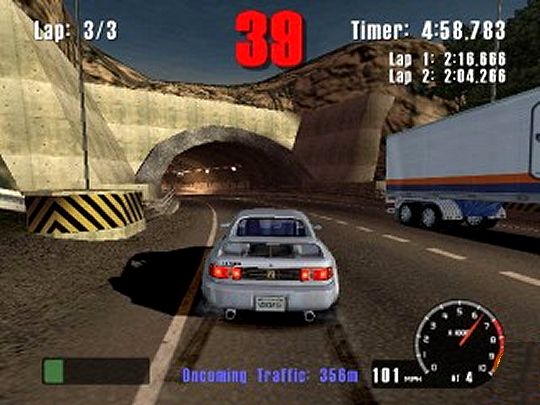
Burnout: a racing game, with a road you can see and everything.
Firing up the first Burnout again is a curious experience. Playing it after the insanely pyrotechnic Revenge, it's drier than a mouthful of Jacob's Cream Crackers, even though the game was inspired by a desire to revert to the simple old-skool excitement of some of the classic racers. ("It's a little bit of Out Run, a lot of Thrill Drive, and partly inspired by the dramatic chase sequences from 'Ronin' and 'The French Connection'," runs the intro to a preview in Edge magazine from September 2001, continuing "But it's possibly also the spiritual successor to 3DO Need For Speed, one of the greatest racers of all time." The rest of the seven-page preview then plummets swiftly into a stupefying litany of "offline toolchains", "memory footprints" and the tremendous sentence "We're pleased with the way we render our trees and lampposts", but you get the tone.)
It's a startling picture of how dull the world of driving games must have been in late 2001 that the preview can throw around phrases like "remarkably exciting" and "unashamedly fast and frantic", because in 2005 Burnout brings to mind words more in the way of "sober" and "tense". Above all else, despite the dangerous-driving gimmick it's actually a strikingly serious kind of game. There are few distractions onscreen, and crashing is a disaster, rather than the raison d'etre - plough into a wall or a vehicle and you get a realistic, unspectacular depiction of a high-speed collision, replayed from several angles just to show you what a mess you made of it, and severe in-game punishment in the form of the loss of half your accumulated "boost". (The game makes a half-hearted attempt at "rewarding" really major smashes with a high-score table of damage caused, but you don't get anything for it in the form of either in-game bonuses or unlockables. The replays also slow down the game's pace, forcing you like a schoolteacher to stop for a moment, calm down and think about what you've done. BAD racing driver.)
The way boost works in the Burnout series is probably the most noticeable difference between the titles in terms of design philosophy, more so even than the evolving attitude towards collisions. In the first game you have to work incredibly hard to build up your boost meter, and almost never get to use it. The meter is heavily depleted by crashes, and you can only trigger a boost when it's at maximum, so if you start to boost, then quickly change your mind and disengage it with (say) 75% of the bar remaining, you still can't boost again until you've refilled the meter to the top. In practice, this renders the whole idea of boost almost entirely irrelevant in gameplay - you'll be lucky if you get to use it once every three races.
Despite all this, and despite being rather slim (with only about half-a-dozen tracks and tournaments) Burnout is a really good racing game. It's gripping, precisely because you have to concentrate so hard on not crashing. Trying to steal a march on your opponents by going up the wrong side of the road into the oncoming traffic is white-knuckle stuff, more so because you can see bends and cars approaching from a long way off, so you know you'll only have yourself to blame for failure. It's the abandonment of this principle that plays the biggest part in the series' descent into cretinity, and it started going wrong immediately.
BURNOUT 2: POINT OF IMPACT
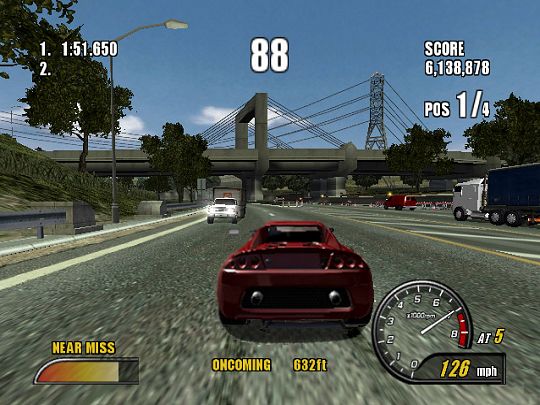
Still quite sober.
Now, it's important to note that in most senses, the last clause in the preceding paragraph is complete cobblers. Burnout 2: Point Of Impact is widely, and entirely correctly, held to be the best game in the series. It marks a huge advance over the first game in almost every regard - the graphics are sharper and brighter, the handling is livelier, the difficulty is a bit less punishing (the first game gets forbiddingly hard from the second Grand Prix onwards), the music is better, boost plays a far more integral part, and there are several varied new types of gameplay, including the immortal Crash mode. But more on all that in a second. What you'll notice almost immediately on playing Burnout 2 after its predecessor is how much more built-up the world you're racing in is. While most of Burnout took place around scenery reminiscent of Ridge Racer (mountain passes and Monte Carlo-esque seaside resort towns), Burnout 2 gets much more urban, with dense city highways and mazy junction systems coming to the fore (although the more scenic styles of the first game are still present). The most crucial effect of this is that draw distance is reduced, and between that and all the extra graphic detail, it gets a lot harder to see where you're going.
Now, being able to see where you're going is a pretty crucial requirement in most games, but rarely more so than in a racing game focused on getting close to, but not hitting, the other traffic. There are too many places in Burnout 2 where, because of the confusing mass of detail at a complex junction obscured by skyscrapers and traffic going in four directions at once, you get a ridiculously small amount of time to react. But the game at least compensates for it in several ways - the better graphics balance out the bad design visibility-wise to some extent, the improved handling gives you more chance to get out of trouble even at very short notice, and the far more generous availability of boost gives you a chance to catch up even if you do crash, so the game isn't wrecked.
And what's more, there's so much to love about Burnout 2 that it's impossible not to forgive it for the flaw. Learning from the first game, Criterion made the drive-dangerously gimmick work a lot better second time around. Not only are the parameters for increasing the boost bar much more forgiving (in the first game you practically had to take someone's headlights off to get some), and not only does the meter get reduced much less drastically for a crash, but in a stroke of genius, you can now earn boost while you're boosting. If you continue to drive recklessly during boost, the meter replenishes at high speed, meaning that if you're good, you can earn another full bar and continue boosting uninterrupted in a "Boost Combo". Racking up a lengthy combo is extremely exciting, all the more so thanks to another inspirational trick, by which the game's audio volume is pumped up during a boost. (The use of sound in general is greatly enhanced in Burnout 2, with audio cues everywhere to tell you when something important has happened, in contrast to the original where you had to keep a close eye on gauges and hard-to-read onscreen text if you wanted to know what was going on. And the music is much less anonymous too.)
The new types of challenge in the main game are a welcome addition too, from ordinary Grands Prix to head-to-head races against single opponents, to Chase HQ-style missions where your objective is to repeatedly ram a specific target vehicle into submission. But best of all, of course, is Crash mode.
Entirely separate to the main game, Burnout 2 offers the lucky player 30 "crash junctions", at which the objective is to cause as much havoc and destruction as possible by instigating huge multi-vehicle pile-ups. It's an innovation of sheer brilliance - if you're frustrated by civilian traffic in the main game, you can take your revenge on it in Crash mode, and the joy of destruction as lines of buses, trucks and vans smash cacophonously into each other accompanied by a gleeful cash-register totting up the ongoing value of damage is almost beyond measure. The crash junctions are blissfully simple and open-ended, offering the opportunity to try endless variations of tactics in an effort to maximise your score, and it's easy to get absorbed in them for hours and forget the normal racing modes altogether.
All these factors combine to make Burnout 2 a shiny diamond of a game, loaded with weeks of top-quality entertainment. But this time, it really would be downhill all the way from here.
BURNOUT 3: TAKEDOWN
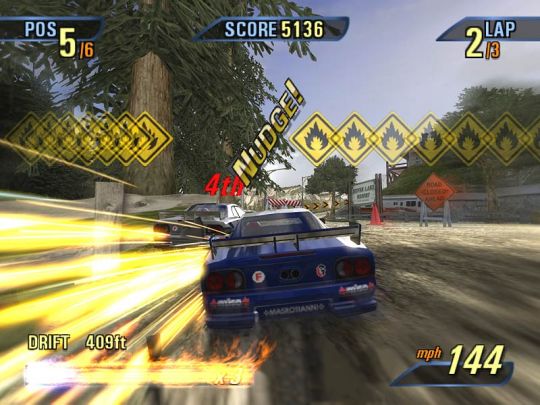
By Burnout 3, things were getting just a tiny smidgen more gimmicky. The sad thing is that conceptually, Burnout 3: Takedown - which was taken up by global publishing behemoth EA after previous owners Acclaim went dumperside - is textbook good sequel design. It takes the proven formula from Burnout 2 and improves on it by enhancing the aesthetics again (notably this time in the form of a fine licenced soundtrack, albeit one disfigured by a widely-loathed DJ) and adding yet another major new gameplay feature - the titular "takedown", or the forcing of a hapless opponent into a catastrophic crash. Now, it was actually possible to make your opponents crash in the first two games, but only in rather limited circumstances (generally blocking them from the side until they collided with oncoming traffic or obstacles). Burnout 3, however, encouraged the player (by using big chunks of boost as rewards) to ram the opposition from all angles, nudge other traffic into their path, smash them into walls and pillars, or just hit them so hard from the rear that they went flying into the air. The appeal of this new aspect to the gameplay is obvious, but Criterion weren't finished yet.
Players whose ravenous appetite for destruction still wasn't sated could take advantage of "aftertouch", whereby even when the player himself was the victim of a crash, their car could be "steered" in the air in an effort to take opponents out in the collision, with the extra help of a slow-motion "crash time" facility and a (sometimes) reverse-angle camera view showing what was coming up from behind. Successfully doing so - or indeed making opponents crash in any other way - awarded more boost, as the feature continued to grow in importance. Now the player could trigger boosting without having to wait for the meter to reach the maximum, a change which further transformed the game, by enabling boost to be used much more tactically - either to avoid collisions with civilian traffic, or to turn an ineffectual bump with a competitor into a full-blown takedown
All sounds great, doesn't it? So what went wrong? The biggest problem with Burnout 3 was that the developers were so keen to maximise the occurrence of these features that they designed tracks so packed with confusing detail, lethal obstacles, blind crests and narrow alleyways opening to 90-degree turns into the middle of two-way traffic, that the player barely ever gets clear visibility of more than about 30 yards ahead of his hurtling race machine (not helped by an absurd over-preponderance of screen furniture, as seen in quite mild form in the picture above). Corners and civilian vehicles loom out of dark tangles of confusing scenery with barely a fraction of a second's notice, and far, far too frequently you find yourself pinwheeling 30 feet into the air with absolutely no idea of what you just hit. The visibility balance of Burnout 2 was completely shot to pieces, and with it went much of that game's challenge as a test of skill.
But the bad news wasn't over. Having made a dog's breakfast of the main game, Criterion now went on to commit the unforgivable crime of screwing up Crash mode too. Ostensibly mostly unchanged (save for the welcome addition of "Crashbreakers", whereby causing enough damage in a crash enabled the player to make their car explode a little while after the initial impact, causing yet more devastation), Crash mode was hideously undermined by the inclusion of "bonus" icons, which if collected as the car flew through the air would confer score bonuses and multipliers of up to 4x (as well as - horribly - negative multipliers, or "dividers" as your grammatically-diligent reporter supposes they should be called).
At a stroke, the freeform, open-ended nature of the crash junctions was thrown in the bin, reducing them to a simple, joyless puzzle with a single correct solution. (Often, the multipliers could be collected with a minimum of actual crashing, turning the entire concept of Crash mode on its head. If you hit the 4x multiplier, you almost inevitably get a gold medal no matter what you do.) Levels even - insanely - ended while there was still major crashing going on. There were over three times as many crash junctions in Burnout 3 as there were in 2 (though several often took place on the same piece of road), but they were barely a tenth as much fun (not helped by a terrible camera which more or less completely spoiled the "Crashbreaker" concept), and it took a grim sense of dutiful dedication - rather than, say, enjoyable compulsion - to unlock them all.
Burnout 3 offered a truly vast amount of content compared to its predecessors, but in order to ensure players got to see it, Criterion removed most of the challenge and skill from the game. Crash junctions rarely took two attempts, and the main race modes were in considerable part a function of luck due to the terrible visibility and unfair course design. (In fairness, 3 is still a mostly good game. It's just that the bad bits - the dreadful Crash mode, rotten city tracks, diabolical cheating AI and the awful, awful "Burning Lap" time trials - were SO bad that they drowned out most of the good stuff.) But gamers have always favoured games with easy goals and lots of bulk, no matter how flavourless that bulk might be, and when the bulk was combined with the flash presentation, high-profile soundtrack and colossal marketing hype typical of EA releases Burnout 3 was a big hit. Another iteration of the franchise, then, could surely only be 12 months away, and so it proved.
BURNOUT REVENGE
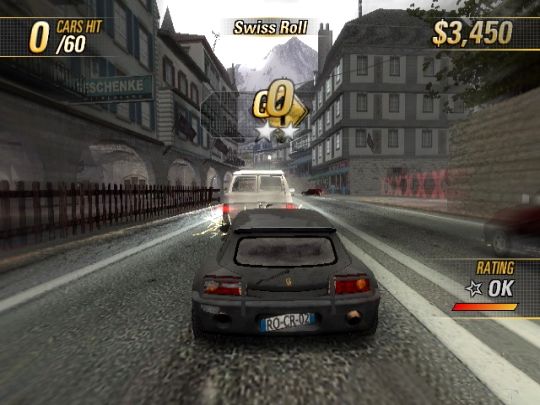
This is about as good a view of the road ahead as you ever get in Burnout Revenge.
Commendably, signing to EA at least hadn't dissuaded Criterion from making real and significant changes to the gameplay of each sequel, and the next game, Burnout Revenge, (characteristically for the games business and EA especially, when a game starts to get embarrassingly over-sequelled the numbers get dropped from the title), stayed true to that principle. Unfortunately, it also stuck with the less-wise principle of fixing things that weren't broken, and Burnout Revenge takes almost everything that was wrong with Burnout 3 and multiplies it severalfold.
Again, though, some credit is due first. For one thing the irritating DJ is absent from the soundtrack, but much more importantly Revenge's Crash mode - by now ill-advisedly fused into the main game rather than a welcome and separate distraction from the racing - repairs the most serious faults from its Burnout 3 incarnation. The bonus icons are gone, and while a special "target car" has been introduced in their stead, hitting it is much less crucial to the completion of a junction than the 4x multiplier had been previously. Multiple crashbreakers are now offered for skilfully prolonged pile-ups (thereby prolonging them even further), and a much-improved camera makes them considerably more fun to use. The preview sweep of the junction first implemented in Burnout 3 has also been usefully extended (albeit at the cost of an annoyingly long delay in starting or restarting a mission). On the downside, each junction now begins with a stupid and pointless "boost start" - a golf-game-style oscillating meter has to be stopped accurately in two small zones or your car will blow up or stall sputteringly on the starting line, necessitating a time-consuming restart - but it's at least easy enough (after a brief learning curve) that it rarely proves a serious obstacle to progress.
The main race modes, however, are where Burnout Revenge really falls apart. The main gameplay innovation this time round is that, building on Burnout 3's takedowns, civilian traffic going in the same direction as you can be rammed, earning boost and sending the civilian cars flying into other vehicles, hopefully including your opponents. In a sense this is a cunning circumvention of the continuing problems with visibility, which again are even worse than in the preceding game, but the effect is to remove practically the last remaining vestiges of player skill required to make progress in the game.
In Burnout Revenge, if you keep your car pointing in very roughly the right direction and keep the accelerator floored, you'll barge traffic out of your way, cause spectacular collisions with enemies you didn't even know existed, be helped around corners by friendly walls, rocket through dramatic shortcuts (another new addition, and a nicely-executed one) and leap across dizzying chasms, and have knocked off the first 30% of the game inside a morning without a moment's tension or doubt ever having raised your heartbeat by a single flicker. This is gaming for poorly-coordinated nine-year-olds with Attention Deficit Disorder, and if you're past puberty and can play it without a nagging sense of embarrassment as the game continually cascades rewards down on you in an exaggeratedly exciteable tone like a children's television presenter training a frisky puppy, then you probably need to address some approval issues with your personality.
The contrast with the first game's white-knuckle terror couldn't be more complete, except in one sense. In Revenge it's close to impossible to exhaust your boost bar, and there's basically no risk attached to using it, so ironically the idea has come almost full circle back to the original Burnout, where in practical terms it might as well not be there at all. Visibility is so poor (by now, the wide-open-country tracks have almost completely disappeared in favour of the cluttered cityscapes) that it's no more dangerous to go at boost speed than at normal, and in the unlikely event that you do manage to hit one of the few remaining things that can still make you crash, the havoc wreaked by the collision (helped by aftertouch and the new inclusion of crashbreakers in some races, as well as in the crash junctions) will ensure you have a practically full boost bar by the time you get going again.
Most racing games are primarily about one of two things - either keeping your car on the track (Gran Turismo, Ferrari F355, Outrun, Project Gotham etc) or avoiding and overtaking the opposition (Virtua Racing, Sega Rally, Outrun 2, Ridge Racer et al). Burnout Revenge, however, offers neither of these challenges. It's essentially an interactive fireworks display, which flatters the player with the illusion that they're somehow responsible for the pyrotechnic carnage onscreen. (For example, the game sometimes rewards the player with a spectacular awards sequence, culminating in the presentation of a magnificent gleaming gold trophy, for executing a "Vertical Takedown". What this actually means is that you drove blind off a ramp and happened by pure chance to land on someone. Go you!)
As such it's not hard to fathom its success with the mainstream videogame audience, but Criterion's willingness to mess with the formula holds out the hope that the definitive racing-and-crashing game that Burnout keeps threatening to be (and came tantalisingly close to with 2) might yet one day appear, retaining all the factors that bring about that financial success yet without rendering the result so incredibly boring to anyone with both an age and an IQ in (at least) double figures. So let's see if we can offer some constructive and optimistic advice to bring that day a little bit closer.
BURNOUT: A BETTER WORLD
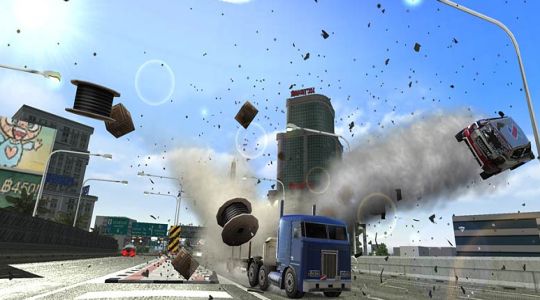
Yawn.
The single change that would do the most to enhance Burnout 5 is a return to the open, high-visibility tracks of the first two games. Outrun 2 shows that modern hardware can cope with massive draw distances AND beautiful graphics AND lots of traffic on the road, so there's no excuse for blinding the player with clutter and cramped environments. (Especially since the next Burnout will probably be on the next-gen formats.) Give us racing and crashing we can actually see and plan and execute on purpose rather than shutting our eyes, flooring the gas and hoping for (and usually getting) the best.
The crash junctions are largely fixed again (apart from those stupid boost starts, which have to go), but they don't belong in the main body of the game. Separating them in Burnout 2 effectively gave the player two very different games for the price of one, a great way of extending the playing life of the whole. (This makes economic sense for the publisher too, because WoS is of the opinion that a great many copies of Revenge will find themselves returned to game stores under the 10-day money-back guarantee, since only a blind one-armed drunk could have failed to complete all, or the vast majority, of the game by then.)
At least some of the time, it needs to be important to not crash into stuff again. Some missions where you have to avoid or minimise damage to your car might be a nice change of pace, and introduce some kind of tiny modicum of challenge back into proceedings. (But not in the form of fucking Burning Laps, okay? If we want to play shitty time-trial modes with no opposition in racing games, we'll generally select them off the special separate Boring Options For Dullards menu.) If it's really true, as we're constantly being told, that the gaming audience isn't just retarded pubescent boys any more, then let's see some fun racing games being made for the people who don't find walking and chewing gum at the same time an insurmountable task.
And most of all, boosting needs to be restored to LOUDNESS.
We're asking nicely, guys. Please make Burnout great again.
|

